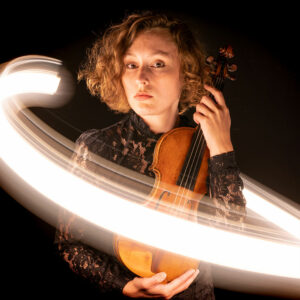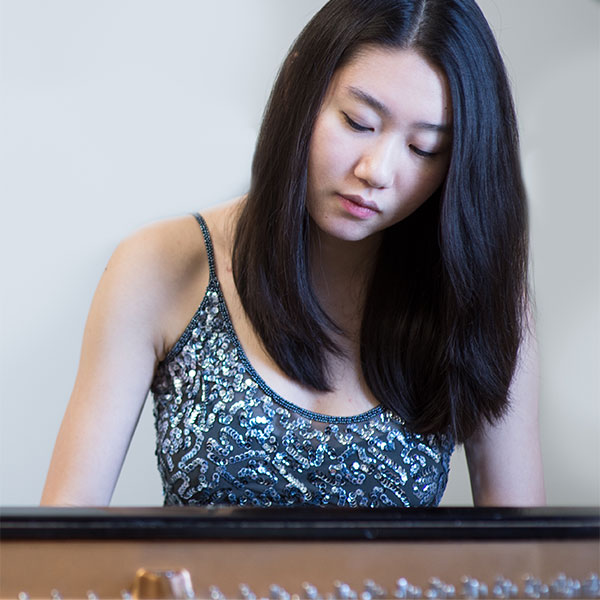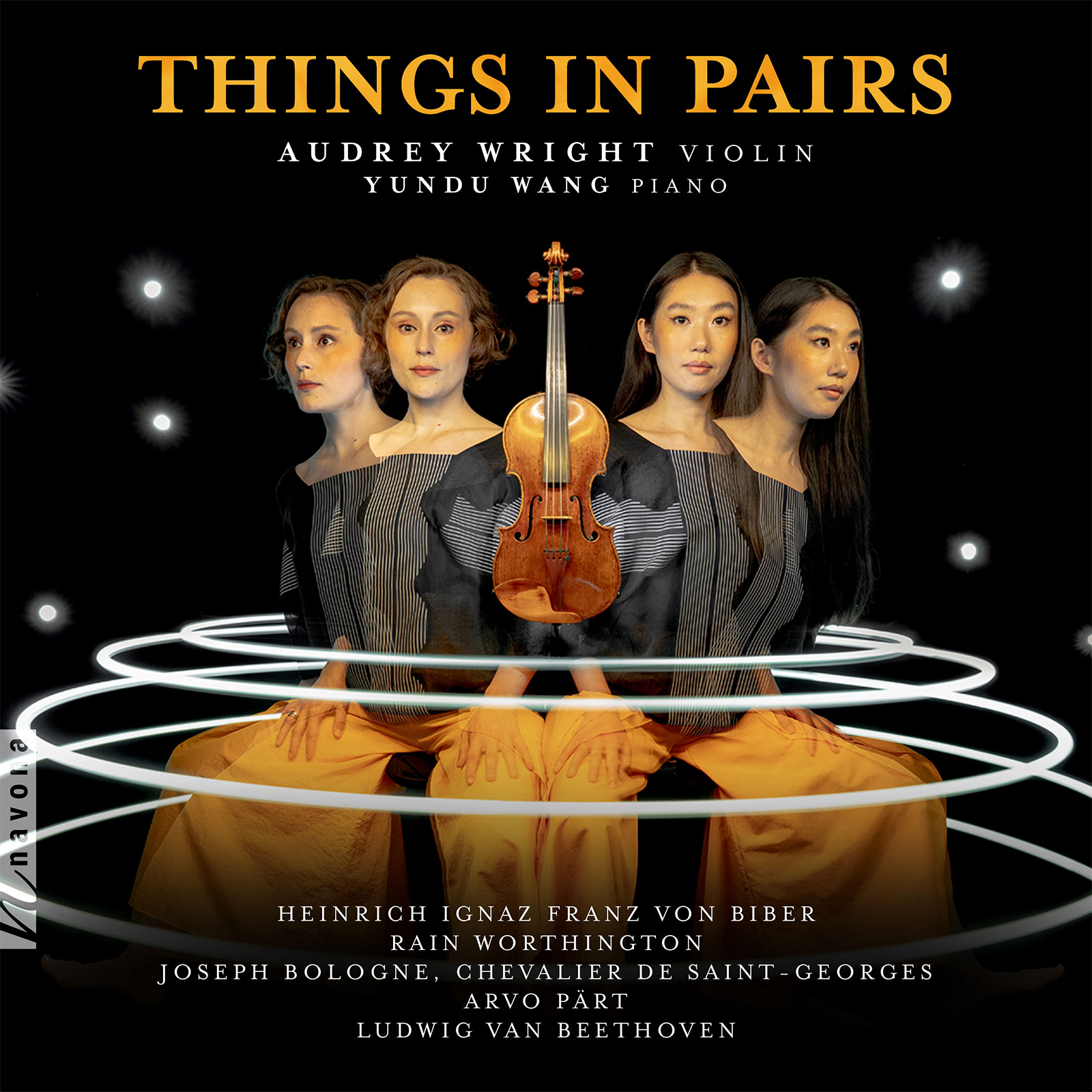Things In Pairs
Heinrich Ignaz Franz Von Biber composer
Rain Worthington composer
Joseph Bologne, Chevalier de Saint-Georges composer
Arvo Pärt composer
Ludwig Van Beethoven composer
Audrey Wright violin
Yundu Wang piano
Concept albums are few and far between, and rarer yet in classical music. THINGS IN PAIRS, a conceptual as well as a musical beacon by violin/piano duo Audrey Wright and Yundu Wang, fills this gap.
The tracks on THINGS IN PAIRS were not just carefully curated – rather, they were selected and sorted with the precision of a steady-handed artist stacking a formidable house of cards. Spanning five centuries, these pieces contrast the classical Joseph Bologne with modern minimalist Arvo Pärt, Baroque virtuoso Biber with the contemporary Rain Worthington, all under the watchful eye of Viennese Classical Beethoven. The true sensation, however, comes in the form of the second, alternate track pairing suggested by the performers, which allows the listener to enjoy the music from a renewed vantage point. Cleverly profound, profoundly clever.
Listen
Track Listing & Credits
| # | Title | Composer | Performer | |
|---|---|---|---|---|
| 01 | Passacaglia for Solo Violin | Heinrich Ignaz Franz von Biber | Audrey Wright, violin | 10:05 |
| 02 | Balancing on the Edge of Shadows | Rain Worthington | Audrey Wright, violin; Yundu Wang, piano | 5:31 |
| 03 | Sonata for Two Violins in B-Flat Major: I. | Joseph Bologne, Chevalier de Saint-Georges | Audrey Wright, violins 1 & 2 | 6:45 |
| 04 | Sonata for Two Violins in B-Flat Major: II. Aria con Variatione | Joseph Bologne, Chevalier de Saint-Georges | Audrey Wright, violins 1 & 2 | 4:24 |
| 05 | Fratres for Violin and Piano | Arvo Pärt | Audrey Wright, violin; Yundu Wang, piano | 11:02 |
| 06 | Sonata for Piano and Violin No. 10 in G major, Op. 96: I. Allegro moderato | Ludwig van Beethoven | Audrey Wright, violin; Yundu Wang, piano | 10:50 |
| 07 | Sonata for Piano and Violin No. 10 in G major, Op. 96: II. Adagio espressivo | Ludwig van Beethoven | Audrey Wright, violin; Yundu Wang, piano | 6:01 |
| 08 | Sonata for Piano and Violin No. 10 in G major, Op. 96: III. Scherzo (Allegro) | Ludwig van Beethoven | Audrey Wright, violin; Yundu Wang, piano | 2:06 |
| 09 | Sonata for Piano and Violin No. 10 in G major, Op. 96: IV. Poco allegretto | Ludwig van Beethoven | Audrey Wright, violin; Yundu Wang, piano | 8:59 |
Passacaglia for Solo Violin
Recorded May 18, 2021 at Meyerhoff Symphony Hall in Baltimore MD
Recording Session Producers Antonino d’Urzo and Kenneth Slowik
Recording Session Engineer Antonino d’Urzo
Balancing on the Edge of Shadows
Recorded May 25, 2021 at Meyerhoff Symphony Hall in Baltimore MD
Recording Session Producers Antonino d’Urzo and Kenneth Slowik
Recording Session Engineer Antonino d’Urzo
Sonata for Two Violins in B-Flat Major
Recorded May 18 and 26, 2021 at Meyerhoff Symphony Hall in Baltimore MD
Recording Session Producers Antonino d’Urzo and Kenneth Slowik
Recording Session Engineer Antonino d’Urzo
Fratres for Violin and Piano
Recorded May 26, 2021 at Meyerhoff Symphony Hall in Baltimore MD
Recording Session Producers Antonino d’Urzo and Kenneth Slowik
Recording Session Engineer Antonino d’Urzo
Sonata for Piano and Violin No. 10 in G major, Op. 96
Recorded May 24 and 25, 2021 at Meyerhoff Symphony Hall in Baltimore MD
Recording Session Producers Antonino d’Urzo and Kenneth Slowik
Recording Session Engineer Antonino d’Urzo
Photography by Geoff Robertson
Executive Producer Bob Lord
Executive A&R Sam Renshaw
A&R Director Brandon MacNeil
VP of Production Jan Košulič
Audio Director Lucas Paquette
VP, Design & Marketing Brett Picknell
Art Director Ryan Harrison
Design Edward A. Fleming
Publicity Patrick Niland, Aidan Curran
Content Manager Sara Warner
Artist Information

Audrey Wright
Violinist Audrey Wright is a multifaceted artist across solo and chamber music, as well as orchestral realms. She is Associate Concertmaster of the Baltimore Symphony Orchestra and Concertmaster of the Baltimore Chamber Orchestra, has performed across the globe in venues such as Carnegie Hall, Boston Symphony Hall, London’s Royal Albert Hall, Saint Petersburg Philharmonia, and the Vatican, and has soloed with the Baltimore Symphony Orchestra, Baltimore Chamber Orchestra, New World Symphony, and Cape Symphony Orchestra. With a passion for innovative programming and juxtaposing a wide range of musical styles, her repertoire spans the early 17th century to modern day and her performing experience includes the full spectrum of these musical styles, from period performance practice to the premiering of new and personally-commissioned works.

Rain Worthington
Believing that creativity is an elemental and essential part of human nature, Rain Worthington has followed her own instinctive path. Self-taught and cross-disciplinary, her creative impulses include concert music and sculptural spaces for attentive reflection. American Record Guide notes a focus of “deep interiority” from “a composer of considerable imagination, emotional expressiveness, and poetic sensibility.”

Yundu Wang
Yundu Wang is a Chinese-American classical pianist currently based in Boston MA. A passionate chamber musician and collaborator, Yundu has performed widely throughout the U.K., United States, and Europe. Notable venues include Barbican Hall, Carnegie’s Weill Hall, Jordan Hall, Sendesaal Bremen, St Martin-in-the-Fields, TivoliVredenburg, and Wigmore Hall. Yundu has collaborated with artists Henk Guittart, Paul Katz, Alan Kay, Roger Tapping, and Sam Walton. She has toured throughout Germany and the U.K. with the Neos Ensemble and violinist Savitri Grier.
Notes
THINGS IN PAIRS was conceived as a collection of works that transcend time and place, defying our preconceived notions of what belongs next to what, and connected by elements of duality, dialogue, and communication. The most quintessential pairings in life bring either complimentary or opposing items together to form something new and meaningful. What this album explores is the vastness in which music creates its own pairings and the unexpected ways in which we can experience that across a particular program; a musical world where the old and new, solo and collaborative, silence and conversation all form a balance of ideas and a freshness of perspective.
Much thought was put into the order of tracks on this album, for how we curate a musical program can have a deep impact on one’s perception of any single work and the relationship between multiple works. In stringing together a narrative across the entire album that also brings attention to individual pairs of works, the listening experience is engaging and immersive. Alternatively, one may choose to listen to any of the following Suggested Alternate Track Pairings for an abridged listening experience, or create new pairings of their own, in order to hear this music in a new light.
2. Balancing on the Edge of Shadows / 5. Fratres
This pairing of the two works on the album written by living composers highlights music that expresses duality. Here, nothing exists without a counterpart. The listener is suspended in the fragile balance of opposites.
1. Passacaglia / 6. Beethoven: I. “Allegro moderato”
This pairing is all about conversation. From an internal, searching narrative to an intimate exchange between friends, the concept of musical dialogue is explored in its many forms.
4. Saint-Georges: II. “Aria con Variatione” / 9. Beethoven: IV. “Poco allegretto”
Celebration of musical form comes to light in this pairing of theme and variation movements. In these two examples of one of the most fundamental musical structures, simplicity is the connective tissue that creates a sense of balance and delight.
Many thanks to Neil and JoAnn Ruther, Edward Manno Shumsky, and Susan D. Kronick, and the many other friends and family who donated so generously to the fundraising campaign for THINGS IN PAIRS.
– Audrey Wright
Video
Audrey Wright, Yundu Wang – Rain Worthington: Balancing on the Edge of Shadows – Music Video

